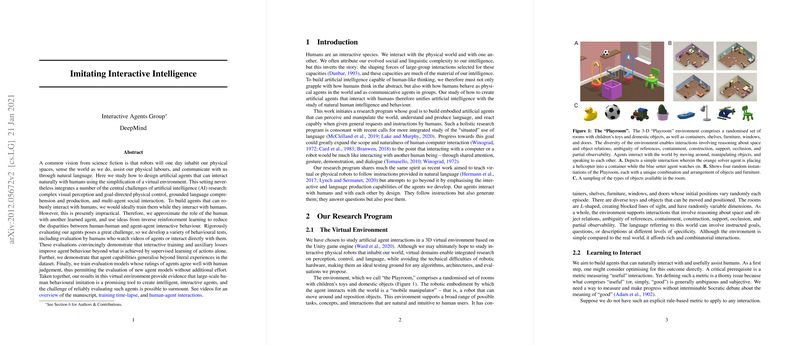Overview of Agent Development and Training
Building intelligent artificial agents that can interact with humans and their environment requires integrating multiple aspects of AI research such as visual perception, motor control, natural language processing, and social interaction. In pursuit of this integration, efforts have been directed towards constructing a virtual environment, termed the "Playroom", populated with diverse objects and governed by the laws of physics. This controllable environment has been instrumental in simulating interactions and collecting large datasets of human behavior, which are essential for training and evaluating artificial agents.
Key Strategies in Agent Training
The training process for these agents is rooted in imitation learning, more specifically, a method called behavioral cloning (BC), where the agent learns by mimicking expert human behaviors captured in the dataset. An essential challenge in this training method is to make the agent's actions less sparse and more discriminative, so it responds contextually appropriate to visual inputs and verbal instructions. To overcome this issue, two main strategies have been employed:
- Language Matching (LM) and Object-in-View (OV) Auxiliary Losses: By using LM and OV tasks, the agents are trained in a supervised manner to align language with vision and identify objects based on expert human behavior, fostering better object recognition and grounding of language in visual perception.
- Generative Adversarial Imitation Learning (GAIL): GAIL involves training a discriminator to distinguish between expert human and agent trajectories, converting its output into a reward signal for the agent. The agent then learns via reinforcement learning to generate behavior that the discriminator judges as human-like.
Interactive Training Environment
Considering the complexity of interactive training, where an agent's behavior must adapt based on a human's real-time feedback, the agents have been trained in both a multi-player interactive environment and a setter replay environment. Some episodes feature pre-recorded human-setter trajectories, providing consistency in the instructions for agents acting in the solver role. This mixed approach aims to build a bridge towards agents capable of engaging with live humans in an interactive manner.
Evaluation Methodologies
The effectiveness of agent behavior and the success of training methods are measured using both automated metrics and human judgment:
- Automated Evaluation Metrics:
Metrics such as the first-object-lifted and object-mention-error-rate evaluate how well agents follow instructions and refer to actual objects in the virtual space.
- Scripted Probe Tasks:
Agents have also been evaluated through procedurally-generated tasks that benchmark their abilities to follow simple instructions and answer questions, allowing for quantitative performance measurement.
- Human Annotations:
Human raters annotate pre-recorded interactions between agents and their environment, or between agents and humans, providing insights into the agents' capacity to generate contextually relevant language and actions.
Scaling and Transfer Learning Experiments
To paper how the performance of agents scales with data and their ability to transfer learned behavior to new tasks, controlled experiments have been conducted. These include training on multiple tasks to determine if multitask learning leads to data-efficient learning for a new task and removing certain object-color combinations from the dataset to test color-object generalization.
Outlook and Future Directions
The integration of perception, control, and language through large-scale data-driven approaches has shown promising results in developing interactive agents. However, further research is necessary to refine agent behaviors beyond imitation to more sophisticated understanding and proactive assistance. Enhancements in knowledge representation, advanced credit assignment techniques, and augmentation of real-world datasets are some of the avenues being explored to achieve genuinely intelligent and versatile agents.
Note: The strategies, results, and methodologies outlined in this post will form the foundation for advancing research on interaction-capable artificial intelligence.
